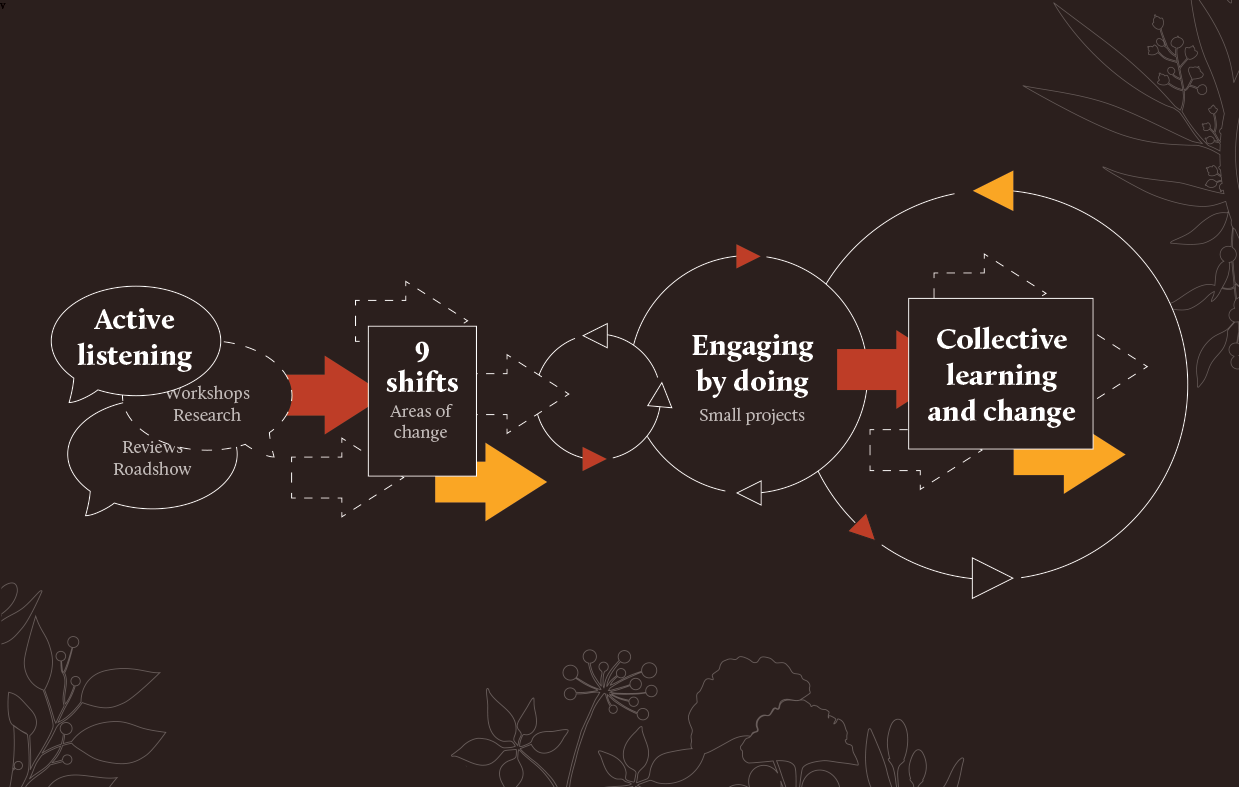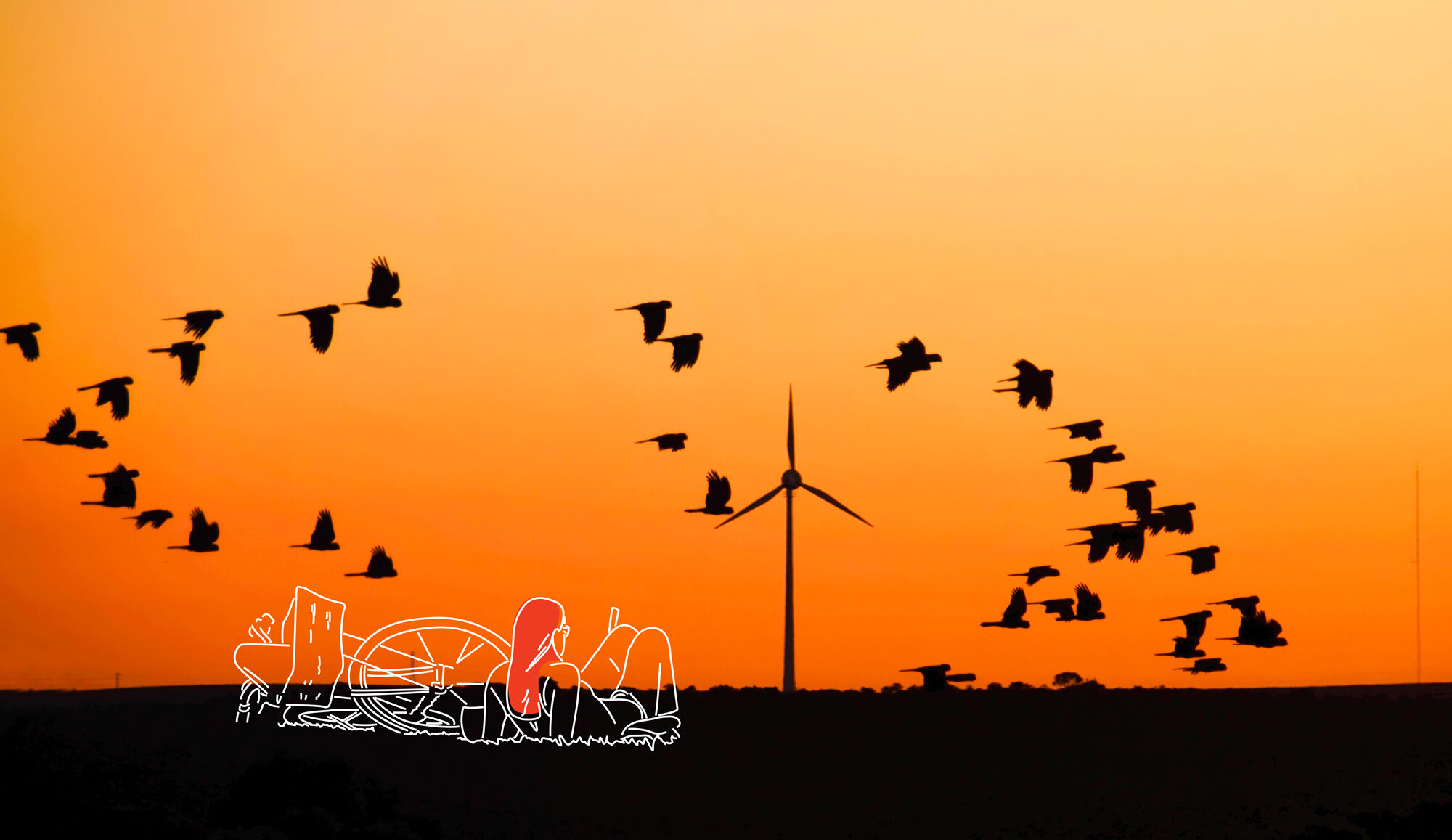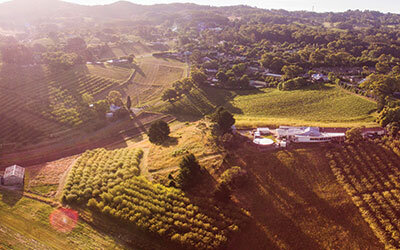
Consultation
Active listening
The Nature of SA was created to be an active and adaptive process. We began by holding conversations with more than 400 practitioners across the state, trying to understand what needs to change to enable better biodiversity outcomes.
We integrated everything we've learned into an early set of draft 'shifts' for the future of how we approach biodiversity conservation in South Australia.
Consulting the sector
Reviews of South Australia’s previous nature conservation strategy (No Species Loss Strategy 2007-2017) indicated that the sector’s awareness of the strategy was high and it was seen as comprehensive and relevant, however over its tenure it had limited ability to influence or drive action for biodiversity conservation in the State.
Workshops with government and non-government conservation partners identified a number of necessary ‘shifts’ in our future approach to conservation.
These shifts were explored with the State’s environment sector over 12 months, at 19 consultation sessions, in every Natural Resource Management region of the State, and involved over 400 individuals.
The ‘sector’ appreciated the opportunity to talk openly about the challenges and to take time to review the way we do business. Many related to Richard Hobbs’ reflection on conservation loss and grief and welcomed the opportunity to discuss. They recognised that many of the discussions facilitated by the Nature of SA project were also being held in the global scientific and popular literature.
Previous strategy
In 2016 an on-line survey investigating the utility of No Species Loss was sent to more than 200 environmental NGOs, community groups, environmental consultants, DEWNR and PIRSA staff and their networks (largely those working in science, NRM, conservation policy and sustainable agriculture).
Reviews of the No Species Loss – a Nature Conservation Strategy for South Australia 2007-2017 indicated that the sector’s awareness of the strategy was high and it was seen as comprehensive and relevant; however over its tenure it largely failed to influence or drive action for biodiversity conservation in the State.
Literature ANd legislation
We reviewed the literature and the legislation. Follow the button below for a list of papers we found most valuable and informative.
Discussion paper
We prepared a discussion paper on the required shifts as the result of eighteen months of consultation and research.
State Forum
Shared understanding
On 20 and 21 February 2017, the Conservation Council of SA hosted a state forum for ‘the Nature of SA’. The purpose of the forum was to discuss what shifts are required to improve our approach to nature conservation and come to an agreed understanding about what’s most important. The forum was held at The Sanctuary, Zoological Gardens.
A targeted group of leaders from across the conservation sector, including from relevant government agencies, were invited to participate, aiming for a balanced representation from across the sector. A number of 'participating observers' from a range of linked sectors and organisations were also invited to provide critical feedback, and guidance on future stakeholder engagement.
A total of ~180 people attended the Forum from all over South Australia. The feedback received during and after the forum supported refining and exploring the shifts outlined in the discussion paper.
Watch highlights from the forum
Nature of SA Forum: Opening addresses
Richard Hobbs: A path from the past to the future
Saskia Gerhardy: a young persons' perspective
Paul Ryan: the 9 Shifts
FORUM PROGRAM
Want to know what happened at the forum? You can watch the videos here or download the program.
Engagement, Capability-building, and Prototyping
Engaging
by doing
By their nature, the shifts are engaged with a global conversation around the edges of our knowledge. They involve new ideas and questions that must be investigated through an iterative process of acting and reflecting, not just talking.
So we hosted leading thinkers (Richard Hobbs, shift #4; Michael Dunlop, shifts #6 and #7), organised capability-building workshops (Common Cause, shift #9), and ran a prototype grant round (Amongst It, shift #2), all as ways to begin to learn more about the shifts in practice.
COMMON CAUSE
We brought Common Cause to Adelaide to offer introductory workshops and masterclasses in positive framing and messaging for the conservation sector. You can learn more about Common Cause here.
Grief and conservation
We hosted Richard Hobbs in the Joinery to talk about how the grief and loss experienced by the conservation sector impact and sometimes limit our work. The video of his presentation has since been shown many times around the state.
CLIMATE CHANGE
We brought Mike Dunlop (CSIRO Climate Risks & Resilience Group) and Paul Ryan (Australian Resilience Centre) to Adelaide. Their Climate Ready workshop used practical exercises to explore the implications of future ecological changes and strategies for building capacity to address those implications.
Love and narrative
We ran a grant round to fund experimental community projects that aimed to bothj build individual relationship with nature and strengthen our societal narrative around nature.
ongoing impact
Collective learning and change
Why didn’t the Nature of SA just do a consultation round, write a strategy and implementation plan and be done with it?
Primarily, it’s because we’re not presenting tried-and-true answers. No one has them. This is a complex, adaptive challenge. Instead, we’ve framed shifts that are engaged with edges of our knowledge in South Australia and as a global society.
We could have just written a document of shifts and be finished, but we all know documents alone drive little change. Reviews of the No Species Loss strategy (2007-2017) indicate that while it was seen as comprehensive and relevant, it drove little action for biodiversity conservation in the State. Regardless of sector, this is the story of many strategies and large-scale change projects: they write a great document and disappear.
So, in contrast to the traditional ‘waterfall’ of strategic plan to implementation, the Nature of SA was structured as an iterative process of engaging by doing. Built on the same foundations of resilience and adaptive planning that we use in our conservation work, this creates a shared learning structure in the sector that extends beyond the group creating the strategy and makes it more likely for the Nature of SA to have a meaningful impact.
A starting place
With these shifts, the Nature of SA determined a starting place to respond to many of the challenges associated with nature conservation in a changing climate. No one individual or organisation will have the capacity to address these challenges on their own or apply all the ideas in this document quickly. Some interest groups will want to see a radical response, others a more cautious approach that tests and builds on what we have done to date. It is likely different groups will propose a range of priorities across research, governance, policy and practice. We should see this spectrum of responses as strength; diverse responses will build resilience in our approach, as long as we learn and share our findings honestly and regularly on the way.
In reality, our approaches will likely involve a combination of all responses. It is critical that we explore every opportunity open to us, understanding it takes time to research, develop, implement and refine practices, to change policy or to shift institutional culture and community action, and that we face the challenges and make a start.
Shift: (verb) to cause something to move or change from one position or direction to another.

The big ideas
9 Shifts
The scale and rate of global changes has compelled us to start looking at nature conservation through a number of different lenses. Building on a discussion paper developed for consideration at the statewide forum, nine areas have been identified where a shift in our thinking and/or approaches and/or actions is expected to foster better outcomes.
Many of the conservation activities we have historically undertaken will continue to be important, however, increasing emphasis should be placed on the identified shifts, starting now.
While these shifts are, in reality, intertwined, they have been broken down into separate ideas in order to communicate them.
Taken together these shifts represent a new paradigm for nature conservation, one built on the legacy of past efforts, but that prepares us for the future. This ‘future-orientated’ paradigm will form the basis of strong and deliberate conservation planning and action going forward.













